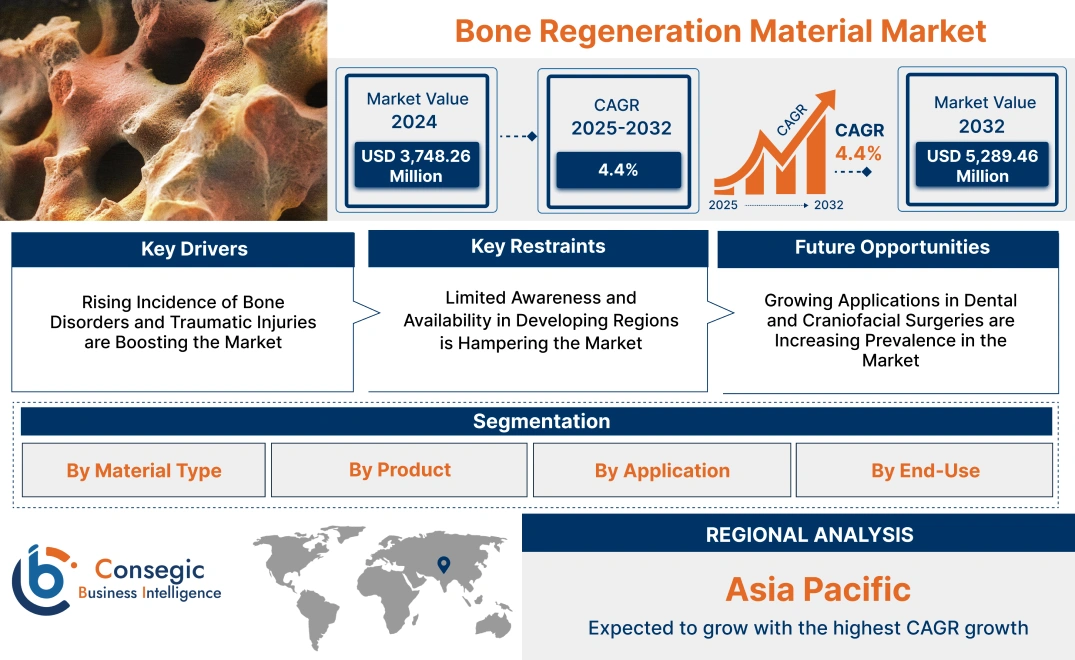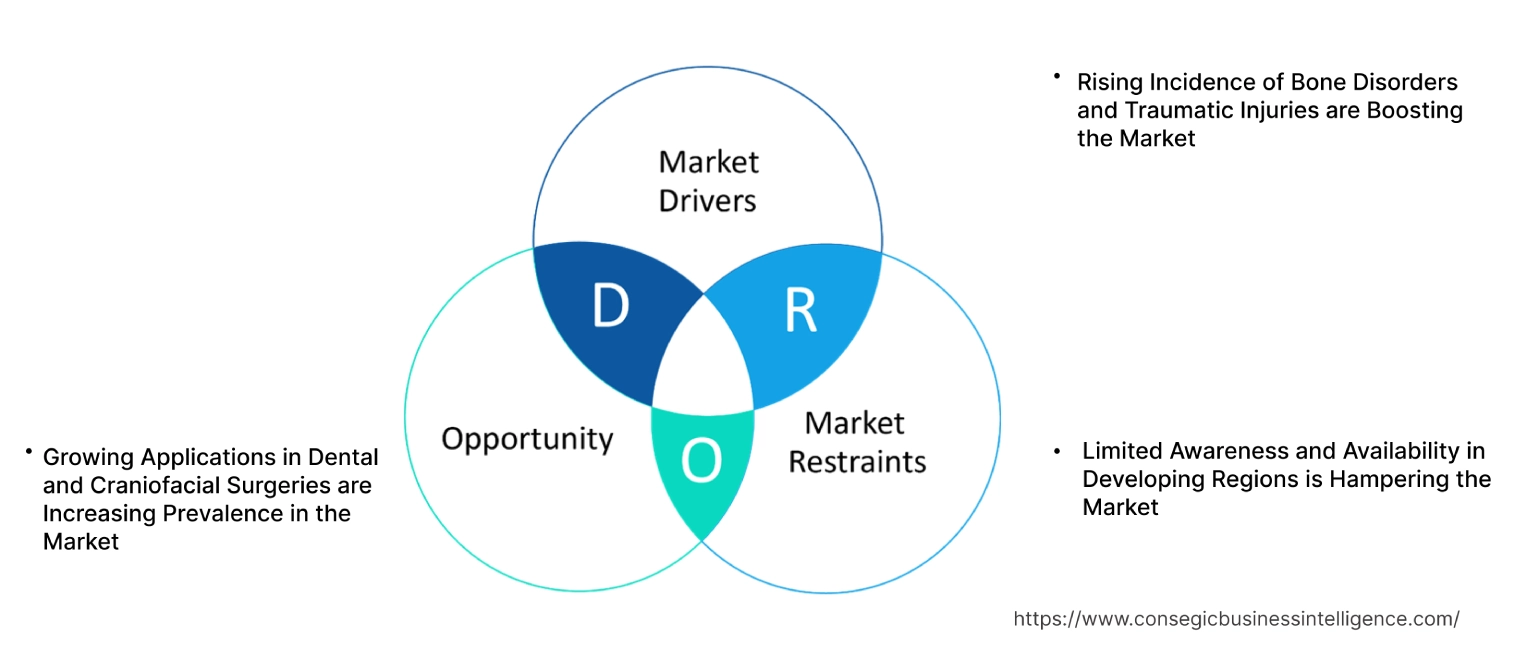Bone Regeneration Material Market Size:
Bone Regeneration Material Market size is estimated to reach over USD 5,289.46 Million by 2032 from a value of USD 3,748.26 Million in 2024 and is projected to grow by USD 3,846.40 Million in 2025, growing at a CAGR of 4.4% from 2025 to 2032.
Bone Regeneration Material Market Scope & Overview:
Bone regeneration materials are primarily used for repairing or replacing damaged or diseased bone tissue. These materials are available in natural and synthetic options, and typically incorporate bioactive components for stimulating bone growth. Moreover, natural materials such as collagen offer improved biocompatibility and a natural matrix for cell attachment, while synthetic materials can be customized for specific properties and degradation rates. Additionally, these materials are used in several applications, including spinal fusion, dental implants, joint reconstruction, craniomaxillofacial surgery, and others.
Bone Regeneration Material Market Dynamics - (DRO) :
Key Drivers:
Increasing prevalence of bone diseases and traumatic injuries is propelling the bone regeneration material market growth
The rising prevalence of bone diseases and traumatic injuries is a significant factor driving the market. Conditions such as osteoporosis, osteoarthritis, and fractures are becoming more common, particularly in aging populations, which is driving the need for bone regeneration treatments. Additionally, rising incidence of road accidents, falls, and sports injuries often result in fractures and bone damage, in turn increasing the demand for regeneration materials. As a result, factors including the rising elderly population, prevalence of orthopedic issues, and increasing incidence of sports-related injuries and road accidents are among the key prospects driving the market.
- For instance, according to the International Osteoporosis Foundation, the total number of fragility fractures worldwide reaches up to 37 million annually, particularly in individuals aged over 55 years, which is equivalent to 70 fractures per minute.
Therefore, the rising prevalence of bone diseases and traumatic injuries such as fractures is driving the adoption of regeneration materials, in turn proliferating the bone regeneration material market size.
Key Restraints:
High cost and operational challenges are restraining the bone regeneration material market
The high cost and operational challenges associated with advanced regenerative materials and procedures are among the primary factors limiting the market. Advanced bone regeneration materials and associated surgical procedures are typically expensive, which creates a barrier to access, particularly in developing countries. Moreover, in certain regions, a lack of awareness regarding the availability and benefits of these regeneration materials and techniques may limit the market expansion.
Additionally, the complexities associated with bone regeneration processes along with concerns regarding its safety and efficacy are further limiting the market. Consequently, the above factors are hindering the bone regeneration material market expansion.
Future Opportunities :
Rising application in dental and craniofacial surgeries is expected to drive the bone regeneration material market opportunities
Bone regeneration materials play a vital role in dental and craniofacial surgeries for assisting in bone repair and development. These materials are mainly used to fill bone defects, promote new bone formation, and facilitate implant integration, among others. Moreover, in dental and craniofacial surgeries, these materials are used for applications involving bone augmentation, bone grafting, guided bone regeneration (GBR), and others.
- For instance, according to the American Dental Association, the total dental expenditures in the United States were valued at USD 174 billion in 2023, accounting for 3.6% of total health expenditures.
Hence, according to the analysis, the rising cases of dental and craniofacial surgeries are expected to boost the bone regeneration material market opportunities during the forecast period.
Bone Regeneration Material Market Segmental Analysis :
By Material Type:
Based on material type, the market is segmented into synthetic materials, natural materials, composite materials, and others.
Trends in the material type:
- Increasing trend in utilization of synthetic materials for bone regeneration due to its several benefits, such as improved biocompatibility, biodegradability, increased availability, and the ability to promote bone development.
- Rising advancements in composite materials for bone regeneration offer a combination of mechanical strength, improved biocompatibility, and bioactivity, which makes them ideal for bone grafts and scaffolds.
The synthetic materials segment accounted for the largest revenue share of 42.30% in the total bone regeneration material market share in 2024.
- Synthetic materials in bone regeneration refer to artificial materials that are used for repairing or replacing damaged bone tissue.
- Synthetic materials used for bone regeneration include calcium phosphate, hydroxyapatite, tricalcium phosphate, bioactive glass, and others.
- Moreover, synthetic materials act as a scaffold, providing a structure for new bone development while promoting healing and regeneration.
- Additionally, the use of synthetic materials for bone regeneration offers a range of benefits, including improved biocompatibility, increased availability, biodegradability, and the ability to promote bone development.
- According to the analysis, the aforementioned benefits of synthetic materials for bone regeneration are further driving its adoption, in turn propelling the market.
The composite materials segment is anticipated to register the fastest CAGR growth during the forecast period.
- Composite materials in bone regeneration combine different materials to mimic bone's structure and mechanical properties, in turn promoting healing and new bone development.
- Composite materials typically consist of a reinforcing phase (such as fibers or particles) embedded in a matrix phase, often a polymer. This combination aims to leverage the best properties of each material to create a material with improved performance.
- Further, composite materials can mimic the structure and function of natural bone while providing improved biocompatibility, biodegradability, and enhanced mechanical properties for bone repair and regeneration, which are key factors driving the market demand.
- Hence, the aforementioned factors are anticipated to drive the market during the forecast period.
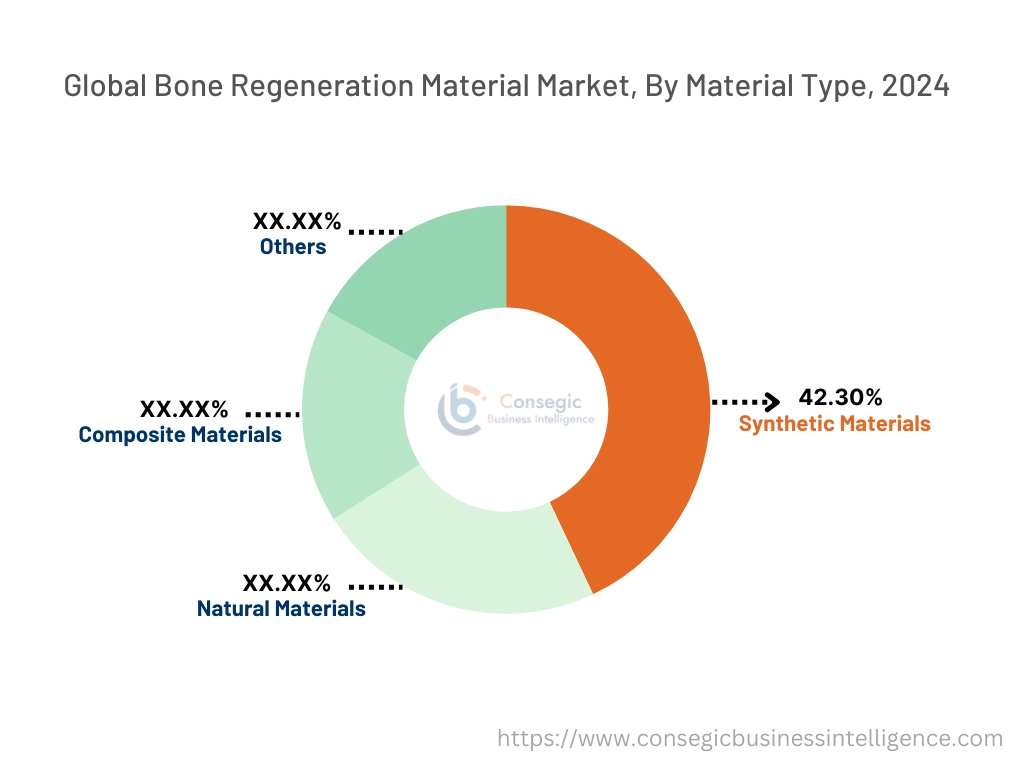
By Product:
Based on product, the market is segmented into demineralized bone matrix (DBM), xenograft, autografts, synthetic bone graft, bone morphogenetic protein (BMP), non-invasive electrical bone growth stimulators, and invasive electrical bone growth stimulators.
Trends in the product:
- Rising trend in adoption of demineralized bone matrix (DBM) in several applications, including fracture repair, bone defect filling, spinal fusion, craniofacial reconstruction, and others, is driving the market.
- Increasing trend in adoption of synthetic bone grafts due to its numerous benefits, including sterility and reduced risk of disease transmission, increased availability in large quantities, and customizable shapes and dimensions.
Demineralized bone matrix (DBM) segment accounted for the largest revenue in the overall bone regeneration material market share in 2024.
- Demineralized bone matrix (DBM) refers to a bone graft material that is primarily used in orthopaedic and spinal surgeries.
- It is created by removing the mineral component from bone allografts, leaving behind the collagen matrix and growth factors, making it both osteoconductive for providing a scaffold for new bone development and osteoinductive for stimulating new bone formation.
- Similarly, demineralized bone matrix offers several benefits in bone regeneration and bone grafting due to its osteoconductive and osteoinductive properties, which promote bone formation and healing.
- Additionally, DBM can be used in several applications including fracture repair, spinal fusion, bone defect filling, and craniofacial reconstruction, among others.
- Therefore, the aforementioned factors are driving the bone regeneration material market trends.
The synthetic bone graft segment is anticipated to register the fastest CAGR during the forecast period.
- A synthetic bone graft is an artificially created material that is used to repair or replace damaged bone tissue, providing an alternative to using bone from a patient's own body (autograft) or from a donor (allograft).
- Synthetic bone grafts are often composed of biocompatible materials such as calcium phosphates or polymers, and they act as a scaffold to support bone regeneration.
- Additionally, synthetic bone grafts offer several benefits, including sterility and reduced risk of disease transmission, customizable shapes and dimensions, increased availability in large quantities, and others.
- For instance, in March 2022, Molecular Matrix Inc. launched its Osteo-P synthetic bone graft substitute for utilization in the musculoskeletal system. The synthetic bone graft is made by using a hyper-crosslinked carbohydrate polymer technology platform that has been developed to optimize the microenvironment for bone regeneration and repair.
- Thus, the rising advancements related to synthetic bone grafts are anticipated to boost the bone regeneration material market growth during the forecast period.
By Application:
Based on application, the market is segmented into spinal fusion, dental implants, joint reconstruction, craniomaxillofacial surgery, trauma repair, and others.
Trends in the application:
- Rising adoption of bone regeneration materials in spinal fusion surgery to promote the fusion of vertebrae and promote healing is driving the market.
- Increasing trend in adoption of autografts, xenografts, and synthetic bone grafts to augment or replace bone that has been lost due to periodontal disease, injury, or other factors is driving the market.
Spinal fusion segment accounted for the largest revenue in the overall market in 2024.
- Spinal fusion refers to a surgical procedure that permanently connects two or more vertebrae in the spine, eliminating movement between them.
- Spinal fusion is mostly performed to stabilize the spine, correct deformity, or relieve pain caused by conditions such as scoliosis, spondylolisthesis, or spinal fractures.
- In spinal fusion surgery, bone regeneration materials are primarily used to promote the fusion of vertebrae. These materials include autografts, allografts, demineralized bone matrix (DBM), bone morphogenetic proteins (BMPs), and synthetic bone graft substitutes, among others.
- For instance, according to the Journal of Orthopaedic Case Reports, nearly 313 million lumbar spine fusion procedures are conducted every year.
- Consequently, the aforementioned factors are driving the market.
The dental implants segment is anticipated to register the fastest CAGR during the forecast period.
- A dental implant is a surgical fixture placed into the jawbone to restore a missing tooth's function and appearance.
- Moreover, bone regenerative materials used in dental implants primarily include autografts, xenografts, and synthetic bone substitutes, among others.
- These materials are used to augment or replace bone that has been lost due to periodontal disease, injury, or other factors, in turn providing a scaffold for new bone development around the dental implant.
- For instance, according to the American Academy of Implant Dentistry, approximately 3 million individuals in the U.S have received a dental implant.
- Therefore, the above factors are anticipated to boost the market during the forecast period.
By End-User Industry:
Based on the end-use, the market is segmented into hospitals, specialty clinics, ambulatory surgical centers, and research institutes.
Trends in the end-use:
- Hospitals are mostly preferred by patients for treatment of bone diseases or traumatic injuries, due to the prevalence of well-developed infrastructure, advanced technology, and skilled healthcare professionals, in turn driving the segment development.
- Factors including the rising bone-related disorders and injuries, advancements in biomaterials, and a growing geriatric population are among the key prospects driving the market.
Hospitals segment accounted for the largest revenue share in the total market in 2024, and it is anticipated to register a substantial CAGR during the forecast period.
- The dominance of this segment is attributed to the high volume of complex spinal, orthopedic, and other trauma procedures conducted in these facilities.
- Moreover, hospitals are widely preferred by patients for treatment of bone diseases or traumatic injuries, due to the prevalence of well-developed infrastructure, advanced technology, and skilled healthcare professionals.
- Further, the availability of advanced technologies and multi-disciplinary expertise in hospitals facilitates positive surgical outcomes for challenging cases related to spinal fusion, joint reconstruction, craniomaxillofacial surgery, and trauma repair procedures.
- For instance, Fortis Hospitals, Max Healthcare, and Apollo Hospitals are few of the hospitals based in India that offers spinal fusion surgery, craniomaxillofacial surgery, and other procedures in its service offerings, which require bone regenerative materials.
- According to the analysis, the above factors are driving the bone regeneration material market size.
Regional Analysis:
The regions covered are North America, Europe, Asia Pacific, the Middle East and Africa, and Latin America.
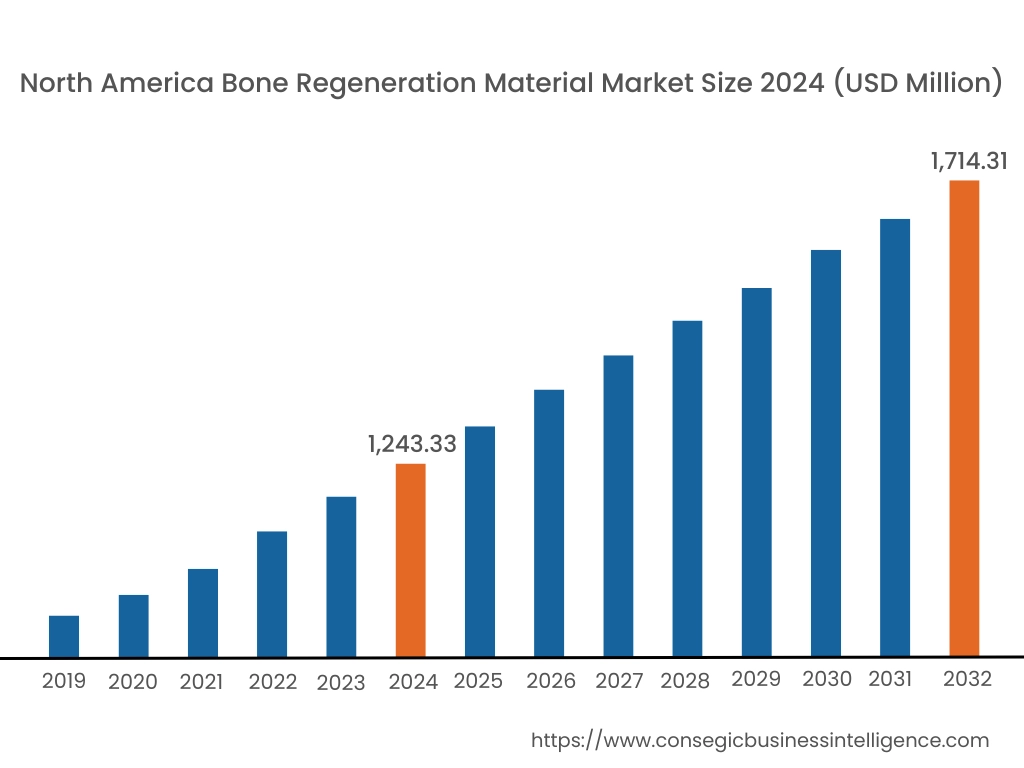
In 2024, North America was valued at USD 1,243.33 Million and is expected to reach USD 1,714.31 Million in 2032. In North America, the U.S. accounted for the highest share of 74.60% during the year 2024. In North America, the growth of bone regeneration material industry is driven by the increasing incidence of bone-related disorders and injuries, rising advancements in biomaterials, and growing elderly population among others. Moreover, the rising adoption of joint reconstruction and craniomaxillofacial surgeries is contributing to the bone regeneration material market demand.
- For instance, according to the American Society of Plastic Surgeons (ASPS), the total number of maxillofacial procedures performed by only ASPS member surgeons reached 52,868 procedures in 2023, representing an increase from 52,488 procedures in 2022. The above factors are expected to boost the bone regeneration material market trends in North America during the forecast period.
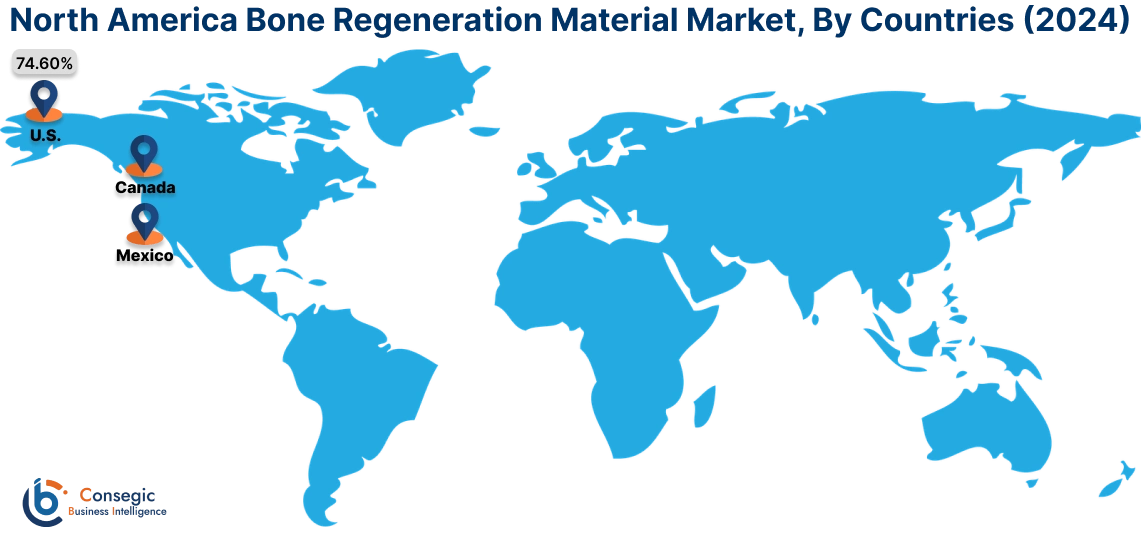
Asia-Pacific is expected to witness the fastest CAGR of 4.8% over the forecast period (2025-2032). As per the bone regeneration material market analysis, the adoption of bone regeneration materials in the Asia-Pacific region is primarily driven by the growing healthcare industry, increasing prevalence of bone diseases, along with the rising development of hospitals and other healthcare facilities in the region. Moreover, the increasing development of hospitals and rising adoption of spinal fusion, joint reconstruction, and craniomaxillofacial surgeries are further driving the market in the region.
- For instance, according to the National Center for Biotechnology Information, India is emerging as a global hub for craniofacial surgery, leveraging on highly skilled surgeons, cutting-edge technology, and affordable healthcare options for attracting patients across the world. Thus, the above factors are accelerating the bone regeneration material market expansion in the Asia-Pacific region.
Meanwhile, according to the regional analysis, factors including rising investments in research & development (R&D) activities associated with advanced materials for bone regeneration along with the prevalence of advanced healthcare facilities equipped with modern technologies and skilled healthcare professionals, focusing on solutions for trauma repair and reconstructive surgeries, are propelling the bone regeneration material market demand in Europe. In addition, according to the bone regeneration material market analysis, the market demand in Latin America, Middle East, and African regions is projected to rise at a significant rate due to factors such as the growing healthcare industry and increasing investments in development of healthcare facilities, including hospitals and specialty clinics, among others.
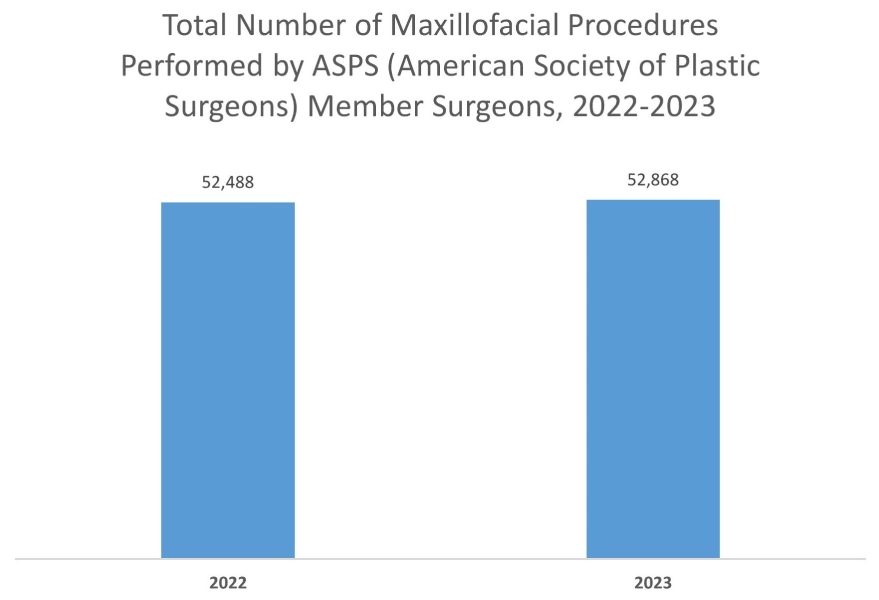
Top Key Players and Market Share Insights:
The global bone regeneration material market is highly competitive with major players providing products to the national and international markets. Key players are adopting several strategies in research and development (R&D), product innovation, and end-user launches to hold a strong position in the bone regeneration material market. Key players in the bone regeneration material industry include-
- Medtronic PLC (Ireland)
- Integra Lifesciences Holdings Corporation (USA)
- Smith & Nephew plc (UK)
- Zimmer Biomet (USA)
- Johnson & Johnson (USA)
- Geistlich Pharma AG (Switzerland)
- NovaBone (USA)
- Citagenix (Canada)
- Sigma Graft (USA)
- Stryker Corporation (USA)
Recent Industry Developments :
Product Launches:
- In April 2025, Xtant Medical Holdings Inc. launched Trivium, which is a DBM (demineralized bone matrix) allograft that is designed for use in bone grafting procedures. Trivium combines three synergistic elements for delivering superior performance in structure, handling, and biological activity while supporting bone repair.
Bone Regeneration Material Market Report Insights :
| Report Attributes | Report Details |
| Study Timeline | 2019-2032 |
| Market Size in 2032 | USD 31,616.84 Million |
| CAGR (2025-2032) | 12.1% |
| By Material Type |
|
| By Product |
|
| By Application |
|
| By End-Use |
|
| By Region |
|
| Key Players |
|
| North America | U.S. Canada Mexico |
| Europe | U.K. Germany France Spain Italy Russia Benelux Rest of Europe |
| APAC | China South Korea Japan India Australia ASEAN Rest of Asia-Pacific |
| Middle East and Africa | GCC Turkey South Africa Rest of MEA |
| LATAM | Brazil Argentina Chile Rest of LATAM |
| Report Coverage |
|
Key Questions Answered in the Report
What is the projected market size of the Bone Regeneration Material Market by 2032? +
Bone Regeneration Material Market size is estimated to reach over USD 5,289.46 Million by 2032 from a value of USD 3,748.26 Million in 2024 and is projected to grow by USD 3,846.40 Million in 2025, growing at a CAGR of 4.4% from 2025 to 2032.
What are the primary applications of bone regeneration materials? +
Applications include spinal fusion, dental implants, joint reconstruction, craniomaxillofacial surgery, trauma repair, and others requiring effective bone healing and regeneration.
What factors are driving the growth of the bone regeneration material market? +
The rising incidence of bone-related disorders, advancements in biomaterials technology, and increasing adoption of minimally invasive surgical procedures are key growth drivers.
